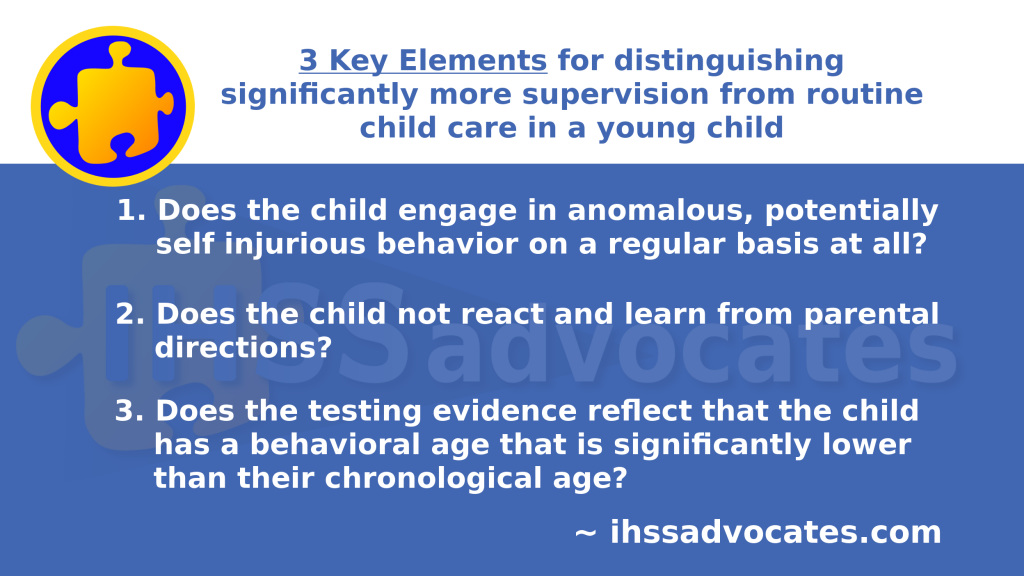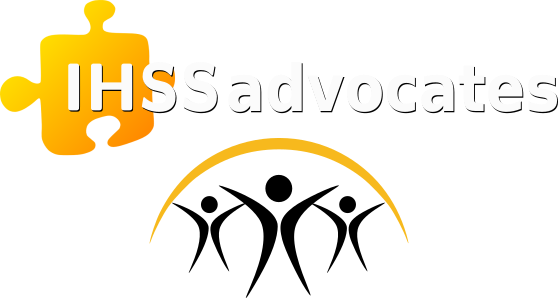3 Elements in Obtaining Protective Supervision for Very Young Children
Advocate, Larry Rosen discusses the three key elements for distinguishing significantly more supervision from routine child care in a young child as young as age three. The two All County Letters and court case that helped define the assessment and determination process of Protective Supervision for children is also outlined in the IHSS video below.
Share Via:
Documents from Video
- ACL 98-87: Clarifying procedures for assessing a minor’s need for Protective Supervision in the IHSS program
- ACL 15-25: Protective Supervision Clarifications
- Item 00-03-01A: California Department of Social Services – State Hearings Division Notes from the Training Bureau – March 27, 2000
Video Notes:
Index – Quick links to topics discussed in the video
- Three Key Elements for distinguishing significantly more supervision from routine child care in a young child
- At What Age Should You Start To Pursue Protective Supervision?
- Assessing Mental Functioning of Minors
- 4 Steps in Assessing a Child’s Need for Protective Supervision
- About Age and Injury
- Question about PS & Age 3 from Item: 00-03-01A
- Anonymous ALJ Comments
- Protective Supervision for Minors History
Protective Supervision for Minors History
When IHSS was first initiated, children were not considered part of the population who would be allowed to get Protective Supervision. It was common for social workers to deny PS without actually doing assessments. It was until 1998 that the outcome of the court case, Garrett vs Anderson, would open the door for children to receive protective supervision.
“In Garrett v. Anderson, the San Diego Superior Court stated procedures when assessing a minor’s need for protective supervision. Among the instructions in Garrett was that when assessing the needs of a minor for protective supervision, the social worker should determine whether the minor needs more supervision because of his/her impairment than a minor of the same age without such impairment. A similar standard should be used when assessing the needs of a child in areas other than protective supervision.” source: Item 95-05-02c
As a result of the court case, All County Letter 98-87 was created to explain the procedures for assessing a minor’s need for Protective Supervision in the IHSS program. The clarification covers procedures for assessing a minor’s need for protective supervision (PS) under Manual of Policies and Procedures (MPP) § 30- 757.17.
In 2015, All County Letter 15-25 was created to update the Garrett rules for assessing children for Protective Supervision and provided clarifications regarding existing Protective Supervision policies. The ACL essentially created a four step process for assessing minors for Protective Supervision.
Assessing Mental Functioning of Minors
A county social worker should always assess an IHSS eligible minor for mental functioning. The following steps must be taken when assessing a minor’s mental functioning:
- The county social worker must review a minor’s mental functioning on an individualized basis and must not presume a minor of any age has a mental functioning score of 1.
- A county social worker must evaluate a mentally impaired minor in the functions of memory, orientation, and judgement.
- A county social worker must assess each minor with a mental impairment for PS based on individual need.
- To assess the minor, the worker must request the parent or guardian to obtain available information and documentation about the existence of a minor’s mental impairment.
- A minor must not be denied PS based solely on age.
4 Steps in Assessing a Child’s Need for Protective Supervision
- Child determined to be non-self directing.
- Must have the mobility to put themselves in harms way.
- Child must require significantly more supervision than a minor of comparable age who is not mentally impaired.
- Need for Protective Supervision must be 24 hours a day.
About Age and Injury
- The social worker must evaluate the mentally impaired/ill child regardless of age.
- The social worker must evaluate the mentally impaired/ill child even if there are no previous injuries.
Question about PS & Age 3 from Item: 00-03-01A
- The county is not permitted to “presume” that a child of any age has a mental functioning score of 1 (i.e., is completely independent and has no need). The county must assess the minor for mental functioning.
- The county must determine whether a minor needs more supervision because of his/her mental impairment than would a child of the same age without a mental impairment. A child must not be denied protective supervision solely based on age or because he/she has incurred no injuries at home due to the mental impairment.
- The county must allow the parent/guardian to provide medical or other information about the mental impairment and must evaluate that information.
- Since the county is not permitted to presume that a child of any age has a mental functioning score of 1, it is possible for three year old Mark to have an established need for protective supervision. The parent/guardian would have to present both medical and testimonial evidence to support the contention that Mark required more supervision because of his mental impairment than would a three year old without such mental impairment.
Anonymous ALJ Comment #1
“In addition, nothing in IHSS regulations limits Protective Supervision to only those with absolutely no degree of understanding what so ever. As stated in, Calderon v. Anderson, IHSS is limited to beneficiaries who are for any reason non-self directing and that they are unaware of their physical and mental problems and unable to watch out for themselves. Additionally, thus, to they extent self-direction comes into play the question is not whether the individual has no ability what so ever to self-direct such as following directions and physical therapy. Instead, the question is weather due to mental impairment the individual is unable to assess danger and the risk of harm. And therefor would most likely engage in potentially dangerous activities that may cause self-harm. Here the record is replete with evidence of the child’s inability to assess danger and risk of harm and is engaging in potentially dangerous activities such as wandering, jumping, and falling. The counties contention that all three year old children require close supervision appears to be based solely on the child’s age and not his inability to self-direct.”
Anonymous ALJ Comment #2
“There is no standard that the Administrative Law Judge is aware of that measures the intensity of a required supervision of a normal child at a particular age. So the only possible measure would be that based on common knowledge. At the age of one and a half a child is just beginning to maneuver and has not developed much in the way of communication skills. It is time when any parent has to provide very intense eyes on supervision. However, when the child reaches the age of two, the child is communicating much better and is usually no longer at risk of continually falling and the supervision can begin to be less. By the time the child is at the age of three there is even a more significant change in the level of supervision required. When using the above measure the documentary evidence and the testimony does reflect a considerably greater need for intense supervision than that required by a normal child. A normal child does not engage in head banging on a regular basis if at all. A child normal will react and learn from parental directions. The testing evidence reflects that this child has a behavioral age that is significantly lower than his chronological age. All this evidence requires the conclusion that the applicant requires far more supervision than a normal child of the same age.”
Three Key Elements for distinguishing significantly more supervision from routine child care in a young child
- Does the child engage in anomalous potentially self injurious behavior on a regular basis at all?
- Worthy of PS
- head banging
- hitting or biting themselves
- behavior is random
- related to mental impairment
- Not Worthy of PS
- crying and kicking is not worthy of PS because it’s not self injurious
- throwing things at people. It’s anti-social and aggressive behaviour because it’s directed towards another person
- Worthy of PS
- Does the child not react and learn from parental directions?
- children does not turn around when you call their name
- children does not respond to verbal prompts
- must you physically intervene to redirect injurious behavior?
- Does the testing evidence reflect that the child has a behavioural age that is significantly lower than their chronological age?
At What Age Should You Start To Pursue Protective Supervision?
It is suggested that you can start pursuing Protective Supervision at age three if you child has a mental impairment and engages in injurious behaviors. You can begin to gather and draft the supporting documents. For example, Regional Center documents, IEP, School Documents, and such.

How to Get Help
If you need any assistance, you are welcome to join our support group at: IHSS Advocacy Group
Click the button below to get a free advocate evaluation of your child’s IHSS Protective Supervision case.
